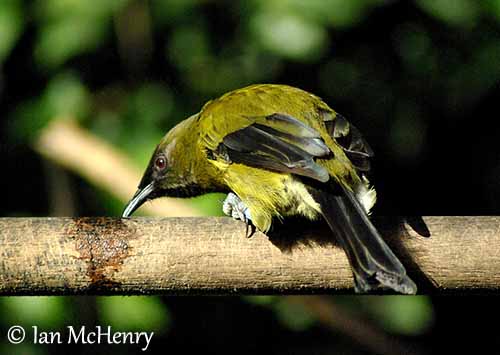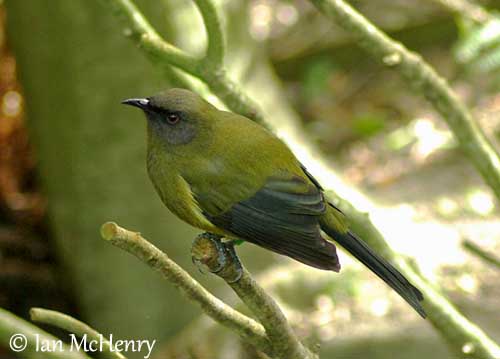
Fr: Méliphage carillonneur
Ang: New Zealand Bellbird
Maori: Korimako, Makomako
All: Makomako
Esp: Campanera de Nueva Zelandia
Ita: Uccello campanello della Nuova Zelanda
Nd: Maori-belhoningvogel
Sd: Nya Zeelandklockfågel
Photographers:
Ken Havard
My Bird Gallery & Flickr gallery 1 & Flickr gallery 2
Patrick Ingremeau
TAMANDUA
Ian McHenry
My New Zealand Birds
Simon Tan
PBase Bird galleries
Text by Nicole Bouglouan
Sources :
HANDBOOK OF THE BIRDS OF THE WORLD Vol 13 by Josep del Hoyo-Andrew Elliot-Jordi Sargatal - Lynx Edicions – ISBN: 9788496553453
KNOW YOUR NEW ZEALAND BIRDS by Lynnette Moon - New Holland Publishers – ISBN: 1869660897
BirdLife International (BirdLife International)
New Zealand bird status between 2008 and 2012
New Zealand birds and birding (Narena Olliver)
Wikipedia, the free encyclopaedia
Te Ara – The Encyclopedia of New Zealand
Tiritiri Matangi Open Sanctuary
Home page
Page Passeriformes Order
New Zealand Bellbird
Anthornis melanura
Passeriformes Order – Meliphagidae Family
INTRODUCTION:
The New Zealand Bellbird’s name pays tribute to its song, well-described by the English naturalist Joseph Banks in 1770. The song is described as “the most melodious wild music…”, or “imitating small bells…” and “the most tuneable, silver sound imaginable…” and can be heard all year round.
This species is common throughout most of the range, and especially on predator-free offshore islands.

DESCRIPTION OF THE BIRD:
Biometrics:
Length: 20 cm
Weight: M: 34 g – F: 26 g
The adult male has olive-green upperparts, with darker upperwing-coverts, whereas the black flight-feathers show bluish sheen. The tail is blackish-brown with narrow, glossy, blue-black edges.
The underparts are olive-green too, with a pale yellowish patch on anterior flanks. Vent and undertail-coverts are pale yellow to white, whereas the undertail is dark brown. The thighs are grey. The underwing is brownish-grey with pale yellow wash on secondary coverts. The leading edge is dark olive.
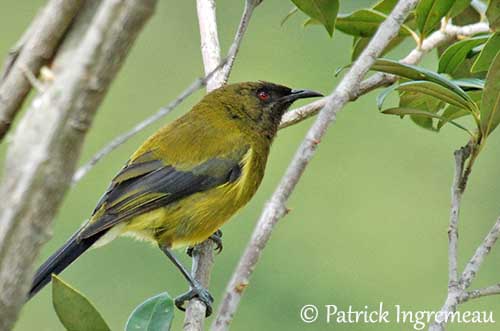
We can see an iridescent purple sheen on both head and neck. The loral area is mostly black.
The slightly down-curved bill is black. The tongue is brush-tipped, allowing the bird to sip the nectar. The eyes are red. Legs and feet are blue-grey.
The female is slightly smaller than the male. She has duller plumage without iridescence, except a weak blue sheen on head and neck, and especially on forehead and crown. We can see a narrow, white moustachial stripe. The pale yellow patch on fore flanks is less conspicuous than on male. The bare parts are similar in both sexes.
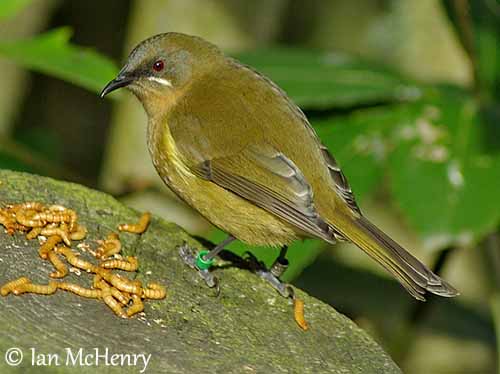
The juvenile male is duller than adults, mostly greyer above and below, whereas head, neck, breast and belly have olive tinge. There is a short, pale yellow moustachial stripe and no patch on fore flanks.
The juvenile female resembles juvenile male, but she is slightly paler and greyer, with brown lores.
SUBSPECIES AND RANGE:
The New Zealand Bellbird has three subspecies.
A.m. melanura (here described and displayed) is found in New Zealand and numerous offshore islands and on Auckland Islands too.
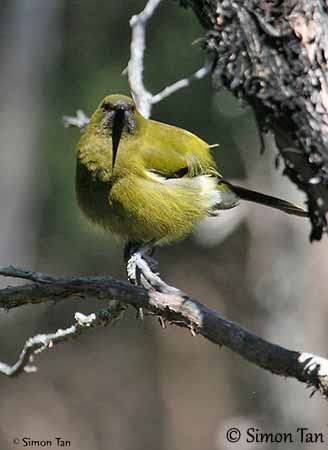
A.m. obscura is found on Three Kings Islands, NW of N North Island in New Zealand. This race is larger than nominate, slightly darker and less yellow overall.
A.m. oneho occurs on Poor Knights Islands, E of N North Island. This one is slightly larger than “melanura” with violet-blue iridescence on male’s head, and greenish-blue sheen on female’s head.
HABITAT:
The New Zealand Bellbird frequents native and pine forests, scrublands, orchards, urban parks and gardens. The species persists in remnants of native forest.
Above the tree-line, it is found in subalpine shrub and scrub, and near swamps, it occurs in flax (Phormium) and tall grass.
It can be seen from sea-level up to 1220 metres of elevation and higher.
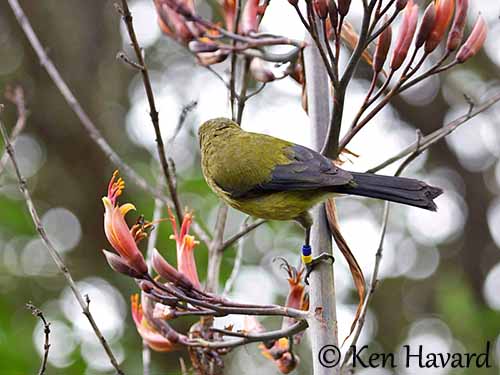
CALLS AND SONGS: SOUNDS BY XENO-CANTO
The New Zealand Bellbird sings throughout the day, but more in the early morning and the late evening.
The song includes three distinct sounds, fairly similar to the chiming of bells. These “bell-notes” are mainly heard when several birds are present, and mostly at dawn and dusk. The birds may sing in perfect unison. Both mates also duet.
The alarm call is a series of loud “tink-tink-tink” rapidly repeated. We can also hear continuous whistling, squeaks and plaintive cry.
BEHAVIOUR IN THE WILD:
The New Zealand Bellbird feeds on nectar from both native and introduced plant species. However, in late summer and autumn, it also consumes fruit and takes honeydew on beech trunks. By feeding in this way, the birds assist pollination and spread the seeds of the eaten fruits.
It also feeds on wide range of invertebrates such as insects, spiders and grubs. It gleans preys from trunks, branches and leaves, and can hawk insects in mid-air.
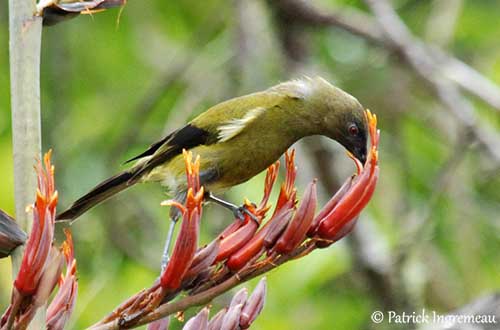
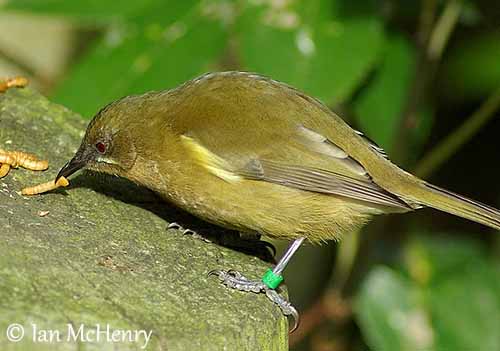
During the breeding season, courtship displays are reported. The male hovers. It flies slowly upwards while producing whirring sounds with its wings.
The New Zealand Bellbird returns to the same breeding territory and has the same partner year after year. They are strongly territorial during the breeding season.
This species is resident in most part of the range. The birds of higher elevations probably move to lowlands, coastal and urban areas in winter. Some dispersion by juveniles is also reported. Both sexes move locally according to food and water resources.
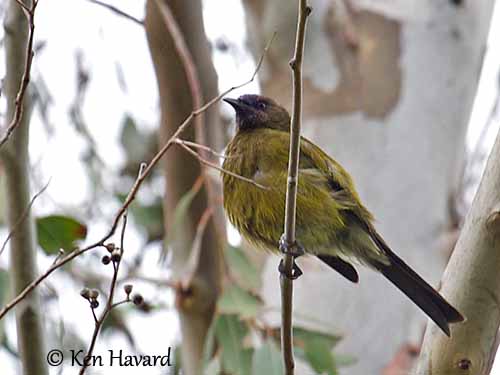
Outside the breeding season, the New Zealand Bellbird may travel some distance to feed.
The flight display by male produces whirring sounds due to the notched outer primaries. It may accentuate this noise during territorial encounters.
REPRODUCTION OF THIS SPECIES:
The breeding season varies according to the range, but usually takes place between September and January.
The female builds a bowl-shaped nest, a loose structure made with grasses, twigs and fibres, and lined with feathers, moss and fine grasses. The nest is well-hidden in vegetation, crevice or hollow in tree, between ground-level and 5 metres above the ground. It is usually built near a flowering tree.
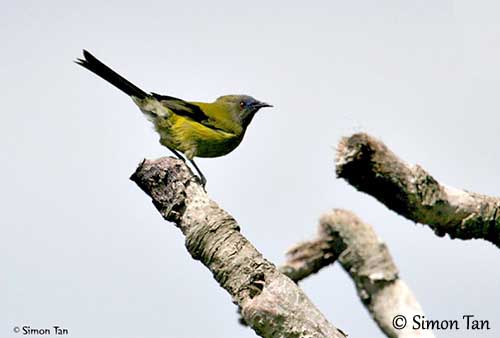
The female lays 2-4 eggs and incubates during 13-15 days while the male feeds her. The chicks are fed by both adults on nectar first, and then, on insects and fruits. They leave the nest about 14-18 days after hatching. They still depend on parents for food for some days or weeks more.
Both parents can be aggressive around the nest-site, and may sometimes physically attack intruders.
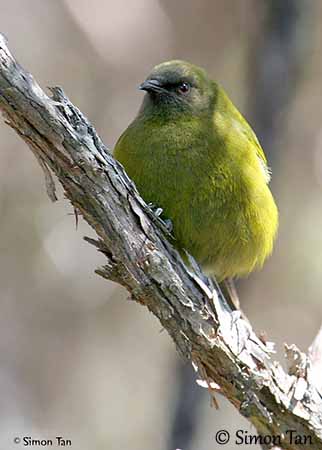
PROTECTION / THREATS / STATUS:
The New Zealand Bellbird is common throughout most of the range, and the densities can be higher on predator-free islands.
The species is threatened by clearance of both native forest and vegetation and degradation of this native forest by possums (Trichosorus Vulpecula).
In spite of reintroduction in several offshore islands, the population is suspected to be in decline, due to habitat destruction and introduced mammals.
Numbers are placed in the band 10,000/19,999 individuals, with 6,000/15,000 mature individuals. The subspecies “obscura” and “oneho” are naturally uncommon.
But currently, the New Zealand Bellbird is evaluated as Least Concern.
